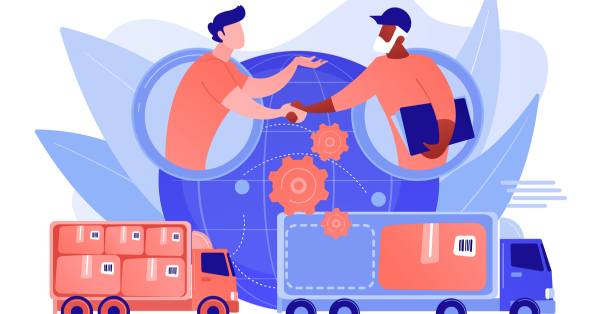
- Products
- Solutions
- Learn
- Partner
- Try Now
As online sales are sky-rocketing, it is also witnessing an inevitable side-effect — growing product returns.
Studies show that around 91% of customers review your return policy before making their purchase. More than anything it gives them security and confidence to make the purchase before physically reviewing the product.
Providing a return policy can work wonders for customer retention and customer satisfaction.
But at the same time, it is also extremely challenging to build the logistical infrastructure for returned goods and the last mile problem in retail.
Currently, the eCommerce industry is witnessing an average return rate of 10.6%.
Around 40% of buyers in the UK and 53% of buyers from Germany returned at least one product in 2020.
Reverse logistics is gaining equal importance as traditional product delivery since retailers realize that the customer’s doorstep isn’t always the final destination of their product.
So they’re increasingly building a process that guides inventory back to a retailer’s warehouse after a customer places a return request.
And while no retailer wants to get their product returned, it is the ugly truth they’ll have to make peace with. The best you can do is smoothly manage the return and enforce steps to avoid them in the first place.
Let’s take a walkthrough of how you can handle product returns and also prevent them.
How to Handle Product Returns?

Implement a Dispatch Software
Handling product returns in online retail are way more complicated than it is in a brick and mortar store. You need to intricately plan the logistics which is expensive and time-consuming.
At this point, it becomes essential to incorporate automation in the process that helps you optimize your delivery process across regions and cities.
Dispatch software sends route plans to drivers’ mobile devices through which the management can check and track the delivery progress. It facilitates transparency which improves operational efficiency, visibility, and customer service. Dispatch software is already used for scheduling deliveries. But some also help you manage your product returns.
Dispatch Software for product returns allows you to optimize your routes by considering the window for both pickup and delivery. You can automatically plan routes that include both activities.
Adopting dispatch software for reverse logistics can help you:
- Accelerate the Return Process: Since you’re adding return logistics with your product delivery process, you’re optimizing the routes and utilizing the driver’s time to the fullest. It increases efficiency in the process and helps you reach your customers faster.
- Gain Insights with Real-Time data: A dispatch software gives you a lot of data, on why the product is returned, what kind of products are getting returned, etc. This helps sales and support teams access insights into making key decisions and track down the causes of returns.
- Manage Returns at Scale: If you have a growing retail business, you’ll encounter a lot of challenges in managing the supply chain. A dispatch software helps you overcome these challenges by identifying irregularities in the supply chain and increasing transparency.
Find a Shipping Partner to Power Your Returns

You probably consider a lot of factors while choosing a 3PL (3rd party logistics) — whether they provide international shipping, hold enough reputation, provide logistics at scale, match the level of your service, etc.
But considering the increasing number of product returns, you need to consider the reverse logistics factor too.
A shipping partner offering reverse logistics stores a retailer’s inventory in a third-party warehouse. It handles the entire order fulfilment process including product returns and it completely falls upon them to inspect the item and process a refund. They then store it on the shelf to be picked for another order.
If you want to build a comprehensive return policy, you need to choose a last mile delivery software that will save your operational costs. Some of the things you need to consider are:
- Does the shipping company provide return labels?
- Does it integrate with your current delivery system and values?
- Are you able to customize for product returns?
Best Practices to Returns management and Save Costs

- Provide High-Quality Product Visuals/Descriptions
When customers are making a purchase from you, they rely entirely on product descriptions and product visuals. Of the few pitfalls of online shopping is that shoppers don’t get to touch and feel the product, or assess its size and quality.
22% of shoppers return products because they don’t match the descriptions. Having a thorough product description is the closest solution to addressing this challenge. If it’s not up to the mark, it is justifiable why the customers would return your product. This is highly prevalent in items like clothing, shoes, and electronics.
You need to regularly update descriptions that accurately match the product. Regardless of the length, ensure that you don’t miss out on crucial information that the customer needs to know.
This can include:
- Weight and the size of the product
- Materials used to make the product
- Size chart
- High-resolution pictures of the product from different angles
- Zoomed-in visuals and product videos
- Your return policy
This will clear the majority of the confusion that customers may have and reduce your product returns.
- Adopt a Liberal Return Policy
We already know how much emphasis customers put on return policies before making an eCommerce purchase. But a lot of retailers are hesitant to frame a liberal return policy just because it adds complexity to logistics.
Since customers want to spend their money right, they want the assurance that they can return the product at their convenience if it’s not the right fit for them.
Providing a liberal return policy can work more so in your favour than against you. A positive return experience fosters loyalty and urges customers to make more purchases in the future and increases your sales. As a customer-centric business, this grows the customers’ confidence to purchase from you.
When prospective customer is browsing through your product, ensure that they can check the detailed return policy. Assure them of the options they have, the time frame within which they can return the product, the instructions for returning the product, etc.
- Leverage Customer Feedback and Reviews
Reviews do matter. If customers cannot experience the product before buying, at least they can make decisions from the people that have. They want to know what the previous customers have to say about the product and how satisfied they are.
A lot of retailers are hesitant to post poor reviews about a product to increase sales. But this can only backfire if the customer ends up having the same feeling as the previous one, they will ask to return. You’ll ultimately have to bear the cost of reverse logistics.
Just like reviews, also leverage customer feedback. If customers are returning a product, ask them the reason and take measures of improvement to avoid the same mistake in future. It will help you improve the overall brand experience and understand common product defects if any.
- Pack and Ship Items Securely
Data shows that 30% of customers return products because they received damaged products. Transportation of goods is one of the riskiest and most unpredictable processes in the supply chain. There’s a big window for things to go wrong. You simply cannot sit back once your product is dispatched.
Even though you’re dependent on your delivery partner to deliver the product in one piece, you can also take some steps to minimize the risks of delivering faulty or damaged products. You can:
- Inspect every item before delivery
- Check their packaging and if they’re bubble wrapped in case of delicate items
- Add a cautionary note if the package has a fragile item inside
- Use correct parcel size so there’s minimum movement inside the package
- Constant Analysis
Returns are probably your least favourite process of the lot. You actually have to revoke the transaction after making rigorous attempts to make a sale. But that doesn’t mean you can’t turn this into an opportunity instead.
Product returns give a lot of insights into what the customers don’t want. The data that you get from product returns helps you identify trends, patterns, and customer behaviour. What products are working best in a particular region, what products are experiencing the highest number of returns, what colours do customers prefer, etc.
Leveraging this data can help retailers understand if certain products are not working for customers, and promote those products that have been a hit. It is useful for everyone — including vendors, marketers, customer success teams, etc. The metrics arm teams with insights that help them make better decisions in the future.
Schedule regular meetings with relevant team members and assign them tasks and objectives. This process will reap benefits in the long run. So have patience and enforce the return prevention plan in a meaningful way.
Wrapping up
Product returns will persist owing to the limitations of online retail. Yet, you cannot give up on preventing returns to optimize your cost and increase your customer experience. How a business handles post-purchase queries of customers says a lot about its credibility and it shows that it truly cares for its customers rather than just closing a sale.
Looking to fix waste and last mile problem such as product returns and cut costs? Tookan can help you overcome last mile challenges by improving efficiency and delivering an exceptional customer experience. get in touch with our experts.
Subscribe to stay ahead with the latest updates and entrepreneurial insights!

Subscribe to our newsletter
Get access to the latest industry & product insights.





















